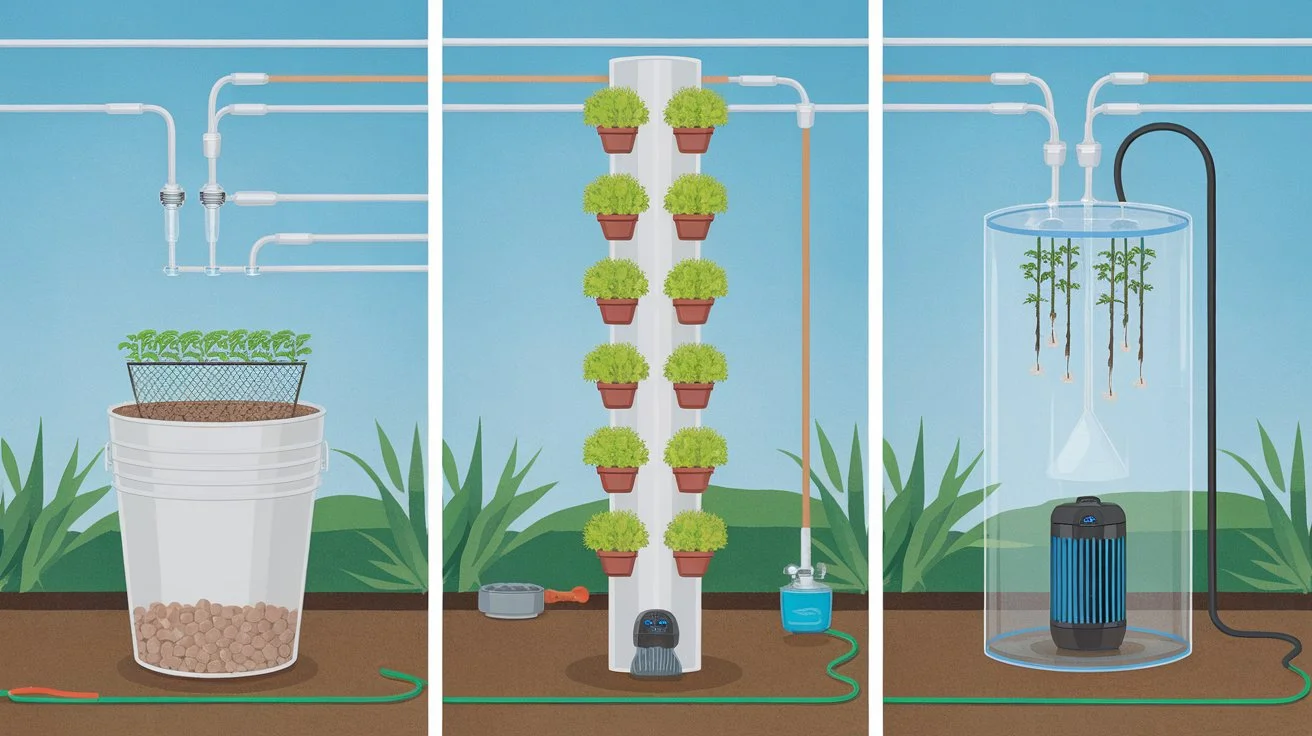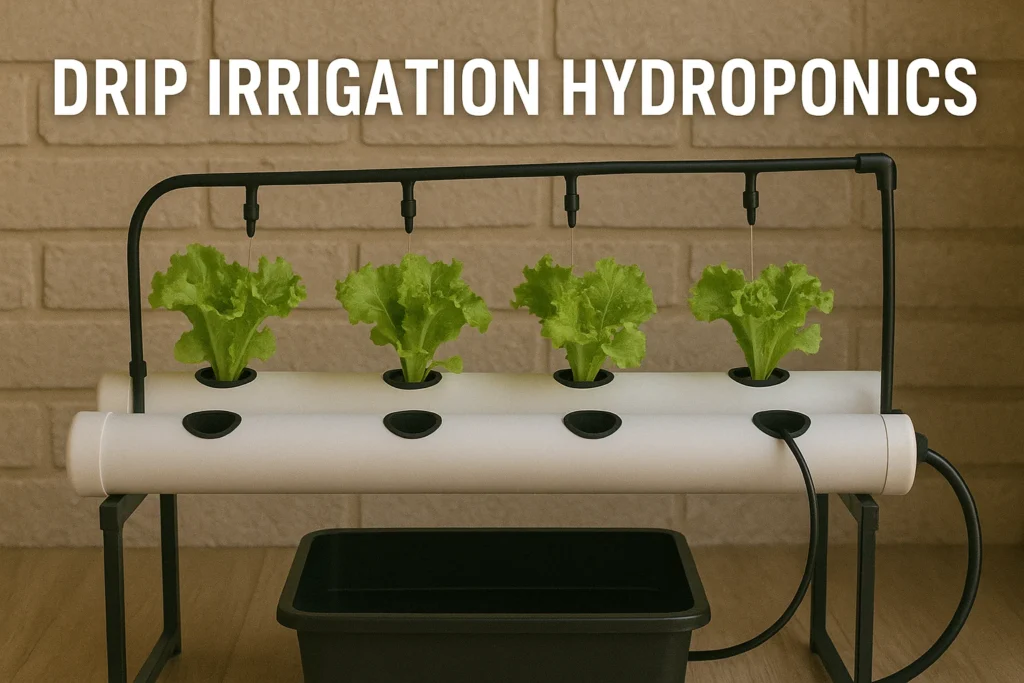NFT vs DWC vs Aeroponics: What Types of Hydroponic Systems Yields More?

When you’re weighing the options for your next indoor garden, the sheer variety of hydroponic system types can feel overwhelming. Deep Water Culture, Nutrient Film Technique, Drip Irrigation, Aeroponics, Ebb and Flow, Wick System—each promises bountiful harvests and minimal fuss. But which truly outperforms the rest? Let’s dive into a balanced hydroponic system comparison, shedding light on strengths, weaknesses, and a few surprising twists.
What Are The Different Types of Hydroponic Systems?
You’ve probably noticed hydroponics popping up everywhere—growing vibrant herbs, veggies, and flowers without a speck of soil. But did you know there are a half-dozen main ways to do it? From Deep Water Culture (DWC), where roots dangle in an oxygenated nutrient bath, to the Nutrient Film Technique (NFT), which channels a thin trickle of solution over your plants’ roots, each method brings its own twist.
Drip irrigation drizzles nutrients at the base of each plant, while aeroponics mists their roots in midair. Ebb and flow systems flood and drain trays on a schedule, and the humble wick system simply draws solution up through a grow medium. What ties them all together is their reliance on water as the delivery vehicle for essential nutrients.
Read on to explore how these different approaches can transform your garden into a year-round, soil-free oasis.
Deep Water Culture (DWC)
Deep Water Culture is often the first system newcomers try. Plants sit in net pots suspended above a nutrient-rich reservoir, their roots submerged in oxygenated water. Proponents praise its simplicity: virtually no moving parts and rapid growth rates. Critics warn of oxygen depletion if your air pump fails—one moment leaves you with lush green leaves, the next a wilted mess. Some gardeners insist DWC delivers the fastest yields, while others argue that without careful monitoring, it’s more temperamental than advertised. To avoid over- or under-watering in DWC, determine watering frequency using our Plant Watering Calculator.
Nutrient Film Technique (NFT)
NFT is all about a continuous, shallow stream of nutrient solution flowing past roots. Advocates point to efficient nutrient use and consistent delivery. Yet, any clog or pump hiccup can dry out roots in minutes. It’s a high-reward, high-risk system—perfect for leafy greens but less forgiving for heavier fruiting crops. The term nutrient film technique suggests a delicate balance, and indeed, many growers oscillate between calling it foolproof and finicky in the same breath. For precise ratios, you can optimize your nutrient solution with our NPK Fertilizer Calculator.
Drip Irrigation
Drip systems trickle nutrient solution onto the base of each plant via drip emitters. It combines the familiarity of traditional irrigation with hydroponic precision. Some gardeners tout its reliability and modular expandability, while others find the emitter maintenance tedious. Drip irrigation feels simultaneously archaic and cutting-edge—it’s neither as hands-off as DWC nor as high-tech as aeroponics, yet it occupies a practical middle ground.
Aeroponics
Aeroponics explained: roots hang in air and mist with a fine nutrient spray. It’s often heralded as the gold standard for oxygenation and rapid growth. And yet, it’s expensive, complex, and occasionally overhyped. Systems can clog, misters fail, and backup plans are a must. In small runs, aeroponics can indeed outperform DWC and NFT, but scale it up and the complexity multiplies. Many growers swear by its efficiency, while just as many revert to simpler setups when things inevitably go awry. For optimal yields in NFT channels, plan your plant density with our Plant Population Calculator.
Ebb and Flow (Flood and Drain)
The ebb and flow system periodically floods the root zone with nutrient solution, then drains it back to the reservoir. This cyclical approach is praised for low energy use and root aeration. However, timers and valves introduce more points of failure. Some claim it’s the best of both worlds—combining root moisture with air exposure—while others argue it’s too bulky for tight spaces and too complex for absolute beginners.
Wick System
At the conservative end of the spectrum lies the wick system: a passive setup where wicks draw nutrient solution up into the grow medium. No pumps, no timers, just capillary action. It’s the simplest, most fail-safe approach—yet it also produces the slowest growth. Many gardeners dismiss wick systems as too sluggish for serious production, but in small herb gardens or for educational purposes, they’re nearly foolproof.
Putting It All Together: A Hydroponic System Comparison
If you’re still undecided, consider a few guiding questions. How much time will you devote each week? Do you prioritize speed, simplicity, or scalability? For leafy greens, NFT may shine, but for fruiting plants, DWC or aeroponics often win out. When water conservation is critical, an ebb and flow or drip irrigation system could be your go-to choice. Don’t forget to monitor your pH and electrical conductivity closely—our guide on [Nutrient Monitoring and EC Tips] offers best practices to keep your solution in balance. For a Comparative Performance of Nutrient-Film Technique and Deep-Water Culture Methods of Hydroponics.
Linking Into the Cluster
Each system deserves its own deep dive. If you’re curious which vegetables and herbs thrive best under each method, check out [Best Plants to Grow Hydroponically]. And for the full context—tips on layout, lighting, and troubleshooting—read about Hydroponics at Home.
Final Thoughts
There’s no single “perfect” hydroponic system. Enthusiasts often switch between DWC, NFT, and aeroponics depending on season, space, and mood. Even the staunchest aeroponics champion might concede that a humble wick system has its place in a windowsill herb patch. Embrace the experimentation: your ideal setup may be a hybrid of two or more methods. After all, gardening is as much art as science, and sometimes the best lessons come from unexpected failures.




